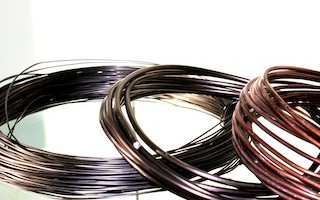Is annealed wire storage stable? It turns out that annealed wire is not stable during storage. It becomes harder over time because of precipitation hardening, a process in which impurities incorporated in a metal slowly react with the metal. The produc ts disrupt the crystal structure of the metal and increase the hardness of the metal. Great! Why in earth do I need to know this and why should I care? It turns out that in the annealing process of both copper and aluminum wire oxygen is dissolved into the metal and the annealed wire slowly becomes harder over time due to the reaction of the oxygen with the metal. The good news is that this process is so slow and so slight under normal storage conditions that it is really not worth worrying about. The rate of hardening increases with temperature so it is probably best not to permanently store your wire is full sun or in a hot attic, but most of us do not do this anyway.
ts disrupt the crystal structure of the metal and increase the hardness of the metal. Great! Why in earth do I need to know this and why should I care? It turns out that in the annealing process of both copper and aluminum wire oxygen is dissolved into the metal and the annealed wire slowly becomes harder over time due to the reaction of the oxygen with the metal. The good news is that this process is so slow and so slight under normal storage conditions that it is really not worth worrying about. The rate of hardening increases with temperature so it is probably best not to permanently store your wire is full sun or in a hot attic, but most of us do not do this anyway.
How long do I leave the wire on? The absolute time limit for leaving wire on a tree is that the wire must come off before scarring takes place and this time depends on how fast the tree is growing. Azaleas are a fast growing tree and probably in six months the wire is ready to be removed, particularly because scarring greatly impacts the appearance of the tree. California junipers are very slow growing and wire can be left on for two or three years before scarring is a problem, and even then, slight scarring can add to the overall texture of the tree.
So how do we manage all this? As a rough rule of thumb wire can be left on most trees for about a year, but it is crucial to frequently check on the condition of the wire on your tree to prevent scarring.
How do I get wire off? The best way to remove wire from a tree is to “unwind” the wire in a single piece from a branch. A temptation is to cut the wire off with wire cutters. While this is a bit faster than unwinding the wire, the risk is that it is easy to overlook a loop of wire, and particularly so on the smaller size of wire. This loop will eventually cut deeply into the branch and, in the worst case, will strangle the branch and cause the branch to die.
And then what? The whole idea of wiring is to hold the branch in a new and, in our infinite wisdom, better position. As the branch grows, it eventually does not need the support of the wire to maintain the new position. After a year, in many cases, the branch cheerfully holds the new position after removal of the wire. But this time can vary significantly from tree to tree, and even branch to branch on the same tree. If the branch does not hold the new position when the wire is removed, the branch must be rewired.
A couple of hard cases are spruce and cedars. These trees never quite get the message that their branches should go in another direction, and it seems that when the wire that has been on for more than a year is removed, the branches issue a mighty sprong and return to exactly where they came from a year ago before they were wired. Much patience and many years of rewiring are needed for these trees to finally get them to do what you want them to.
A technique that sometimes helps is to gently flex the branch several times before establishing the final position of the branch. The flexing of the branch causes small cracks in the branch and when the branch is positioned, the cracks slowly heal over time to form scar tissue which helps to hold the branch in the new position.
Can I anneal copper wire that has been removed from a tree so that I can reuse it? All you need to do to anneal copper wire for reuse is to heat it until it glows a dull red color. A propane torch will do the trick, although you have to be sure that the entire wire is heated to this temperature. Either you must straighten the piece before annealing, which is not easy for the larger sizes of wire, or you anneal the piece, straighten it and then anneal it again. If you manage to do all this successfully, you are still stuck with a relatively short piece of wire. Although all this is possible, is it worth the hassle? It probably is not for most of us.

